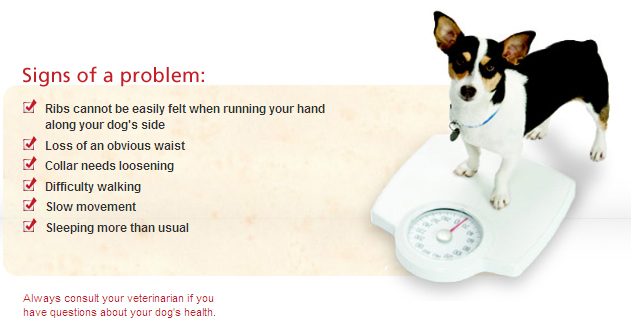Is your dog overweight?
By Jean Gill
Life gets busy.
You work all day and then you have to run off to your kid’s activities after work. By the time you get home there is dinner, homework and housework.
Many people do not have the energy or time to exercise the family dog like they should and typically end up just turning the dog outside into the fenced in backyard, hoping they’ll run and do their own exercising. Then you start to feel guilty because you’re not giving your dog the attention it needs so you give in to those big brown eyes and feed it samples from your dinner plate or snack bag.
Your dog starts to get bigger and bigger.
Pretty soon you notice that your dog struggles to get up from lying down and when you do have time for a walk, he is lagging behind you, panting profusely and may even sit down and refuse to walk any further.

Canine obesity is one of the fastest growing health problems seen in dogs today. As with people, obesity can lead to a variety of diseases, disorders and other complications in dogs.
In a 2008 study, the Association for Pet Obesity Prevention estimated that 44% of U.S. dogs were overweight or obese. That’s approximately 33 million dogs in the U.S. alone. Needless to say, something must be done.
You can start with your own dog by learning how to manage your dog’s weight, starting a weight loss plan for your dog, and preventing weight gain in the first place.
Obesity in dogs can lead to several other dangerous health conditions. It may also adversely affect an existing health issue. The following diseases and disorders may be caused or exacerbated by obesity:
◆ Cardiac disease
◆ Diabetes Mellitus
◆ Hypertension (high blood pressure)
◆ Orthopedic injuries (such as cruciate ligament rupture or patellar luxation)
◆ Osteoarthritis
◆ Respiratory disorders
◆ Various forms of cancer
There are many reasons a dog can become overweight. Improper diet and lack of sufficient exercise are two of the main reasons. If a dog has had an illness or injury and is required to remain sedentary, it is therefore at risk for weight gain.
It is also important to know that weight gain may actually be a symptom of some hormonal disorders, such as hypothyroidism or Cushing’s syndrome. Finally, genetic predisposition is a big factor. Certain dog breeds are simply more prone to obesity than others, such as English Bulldogs, Beagles, Dachshunds, Pugs, Dalmatians and Cocker Spaniels – just to name just a few.
How do you determine if your dog is overweight? Run your hands along the side of your dog – you should be able to feel the ribs of your dogs without having to press into your dog. Inability to feel the ribs is a sign your dog is possibly overweight. Look at your dog from above – do they have a waist? (see picture below) If they do not or it is only slight, they are probably overweight.

Is your dog overweight? (Photo courtesy of: DogZenergy)
If your dog is overweight please consult your vet to get your dog on a healthy diet and obtain a good goal weight to strive for and develop a safe weight loss program for your dog. Exercise will be a big part of your dog’s weight loss program and utilizing the underwater treadmill (UWTM) at Four Paws Fitness & Rehab will be of great benefit to your dog.
The UWTM will decrease the stress on your dog’s joints while still giving them a great workout and help them to burn calories. Other services that Four Paws Fitness & Rehab offers that can help your dog lose weight are conditioning work outs that strengthen their core muscles (kind of like when we do crunches) and endurance enhancing exercises.
Please contact Jean at Four Paws Fitness & Rehab to help your dog achieve a healthy weight and live a longer and happier life.
